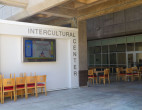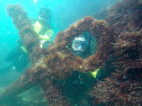The Oct. 31 deadline for the Santa Clarita Valley Sanitation District to create a plan to reduce chloride levels at the SCV watershed, is mere months away.
Los Angeles Regional Water Quality Control Board officials have expressed doubt that the district will be able to meet the deadline and that they are just using negotiations to buy time.
On July 19, the Santa Clarita City Council received a letter from RWQCB Executive Officer Sam Unger, in response to a letter from Mayor Bob Kellar following the April 23 City Council meeting that Unger attended.
“We thank you for being so generous with your time to present the information, answer the City Council’s questions, and listen to the viewpoints of our residents,” Kellar said in his letter. “The City Council would very much appreciate your written response to the attached list of questions asked during the meeting and providing the additional data you agreed to send during the meeting.”
Unger’s response gave detailed answers to questions that were posed during the meeting, including how state and federal governments determine water quality standards, whether the board’s technical advisory panel was weighted toward Ventura County interests and why other areas have different total maximum daily limits for chloride than the Santa Clarita Valley.
Kellar’s letter also brought up the fact that imported water from the State Water Project includes high levels of chloride, to which Unger responded that local urban users are responsible for pushing chloride concentrations above the limit and thus responsible for reducing concentrations.
Unger also listed those cities and local water districts that had challenged total maximum daily limits set by a water quality control board. The court consistently found in favor of the water quality control boards and upheld the TMDLs.
Unger said in the letter that he appreciated, “the opportunity to answer your questions and to clarify remaining issues.”
Below is the full text of Unger’s response to Kellar’s letter.

Click to enlarge
Answer to Santa Clarita City Questions Following City Council Meeting on April 23, 2013
1. Chloride TMDL for the Santa Clara River
a. What is the basis for the Federal (USCWA) and State water quality standards, and why does this apply in the Santa Clarita Valley?
Water Quality Standards are the foundation of the water quality-based pollution control program mandated by the Federal Clean Water Act (CWA), and are required for all navigable waters in the United States. Set by each state, those standards regulate how clean a water body must be, and include the water body’s designated uses, and the numeric and narrative water quality criteria to protect those uses, and a provision to prevent degradation of high quality waters. In California, water quality standards are set by the State and Regional Water Quality Control Boards and approved by the United States Environmental Protection Agency. Because the Santa Clara River is a navigable water within the United States, water quality standards apply.
b. Who was on the Technical Advisory Panel for scientific studies review, and what was each person’s organizational affiliation?
The Technical Advisory Panel comprised a panel of experts in the fields of agriculture, chemistry, and soil science. The following individuals served on the Panel:
Oleg Daugovish, Ph.D. -University of California Cooperative Extension, Ventura. Dr. Daugovish serves as the farm advisor for strawberry and vegetable crops with the University of California Cooperative Extension for Ventura County. He conducts research and educational programs with emphases on pest control and environmental quality of production, addressing the needs of organic farmers. He has also served as a research assistant with the Department of Plant, Soil and Entomological Sciences at the University of Idaho; Department of Agronomy at the University of Nebraska; and the Stensund Ecological Center. Dr. Daugovish received his Ph.D. from the University of Idaho; M.S. from the University of Nebraska, B.S. from Latvia University of Agriculture.
Ben Faber, Ph.D. -University of California Cooperative Extension, Ventura. Dr. Faber works with the University of California Cooperative Extension for Ventura County, serving as the soils/water/subtropical horticulture advisor. He has research experience in plant nutrition and soil management. His research focuses on irrigation requirements of avocado and citrus, methods of controlling groundwater nitrate pollution, effects of yard waste mulches on citrus production and various methods for controlling micronutrient deficiencies in avocado. Dr. Faber received his Ph.D. from the University of California, Davis; M.S. Soil Fertility, University of California, Davis; B.S. Biology, University of California, Santa Cruz.
S.R. Gratten, Ph.D. – University of California, Davis. Dr. Grattan is a professor at the University of California, Davis, where he serves as the plant-water relations specialist in the Department of Land, Air, and Water Resources, Hydrologic Science Division. His research areas include irrigation management with saline water; plant response in saline environments; uptake of nutrients and trace elements by plants in saline environments; and crop water use. He also performs international consulting work with the World Bank, USDA/OICD, and USAID, and has previously served as a research assistant with the University of California, Riverside, and as a research plant physiologist at the USDA/ARS Salinity Laboratory. Dr. Grattan received his Ph.D. in Soil Science from the University of California, Riverside; M.S. in Soil Science from the University of California, Riverside; B.S. Soil and Water Science from the University of California, Davis.
John Letey, Jr., Ph.D. – University of California, Riverside. Dr. Letey is Professor Emeritus of Soil Science, Soil and Water Sciences Unit, University of California, Riverside and Director of the Center for Water Resources, University of California, Riverside. He has also served as the Chair, Department of Soil and Environmental Sciences; Director, University of California Kearney Foundation of Soil Science; Associate Director, University of California Water Resources Center; California State Water Quality Coordinator; and Director, University of California Salinity/Drainage Program. His research areas include irrigation, salinity, drainage, and plant-water relationships. He received his Ph.D. in Soil Science from the University of Illinois, and his B.S. in Agronomy from Colorado State University, and has served on numerous state, federal and international advisory committees; University of California and Soil Science Society of America task forces and committees; and editorial boards.
Darrell H. Nelson, B.S. – Fruit Growers Laboratory, Ventura. Mr. Nelson is a consultant with Fruit Growers Laboratory, and a farm operations manager and farmer in Ventura County. He is the former President and Laboratory Director of the Santa Paula and Stockton Fruit Growers Laboratory. He received his B.S. in Soil and Water Science from the University of California, Davis, and has made presentations on the use of scientific information to implement best management practices and the use of nutrient budgets. He has also been active in the appraisal of drinking water quality for regulatory purposes and irrigation water for suitability to specific crops. He has advised the Los Angeles Regional Water Quality Control Board on Best Management Practices and the use of Nutrient Budgets as they relate to Total Maximum Daily Loads (TMDLs), and is currently serving on the California Avocado Commission Research Committee as co-chairman of the management and physiology subcommittee.
Kenneth K. Tanji, Sc.O. – University of California, Davis. Dr. Tanji was a Professor Emeritus of Hydrology, Department of Land, Air and Water Resources, University of California, Davis. He also served as the Senior and Principal Laboratory Technician, Department of Irrigation; Lecturer in Water Science, Department of Water Science and Engineering; Professor of Water Science, Department of Land, Air and Water Resources; Vice Chair and Chair, Department of Land, Air and Water Resources; and Professor of Hydrology, Department of Land, Air and Water Resources. He had more than 45 years of research experience dealing with salinity in agricultural lands in California, the Western U.S. and foreign countries, and was involved with developing a salinity management guide for irrigation of landscapes using recycled water. Dr. Tanji received his Sc.D. in Agricultural Science-Irrigation, Drainage and Hydrological Engineering from Kyoto University; M.S. in Soil Science- Soil Chemistry from the University of California, Davis; B.S. in Chemistry from the University of Hawaii.
c. How was the Technical Advisory Panel an independent review? Was this panel weighted toward Ventura County interests?
The Technical Advisory Panel (TAP) was selected by the Santa Clara River Chloride TMDL collaborative process, which was overseen by the Sanitation Districts and the Los Angeles Regional Water Quality Control Board, in consultation with other stakeholders in the upper Santa Clara River area. As described above, the TAP was comprised of members of academia. The TAP met several times over the course of the study to provide oversight and advice to the collaborative process group. The Panel’s purpose was to examine the draft Literature Review and Evaluation, to evaluate it in light of the existing designated uses of the Santa Clara River and to come to a decision as to its completeness and accuracy.
d. You said various federal and state entities approved the scientific studies review. Which entities are these?
The draft Literature Review and Evaluation was reviewed by the State Water Resources Control Board and the United States Environmental Protection Agency. In addition, the TMDL revisions resulting from the findings of the Literature Review and Evaluation were released for public comment prior to adoption by the Regional Water Quality Control Board, and approved by the State Water Resources Control Board and the United States Environmental Protection Agency.
e. How many documents in the scientific studies review were used to set the TMDL?
The Literature Review and Evaluation cited 225 documents that were used to support the TMDL.
f. Do the documents reviewed show there was no impact from chloride to crops and the only impact identified was leaf burn?
The documents do not show that the only impact identified is leaf burn. The Literature Review and Evaluation examined both leaf tip burn and crop yield. The Literature Review and Evaluation defined the maximum chloride concentration based on when plant injury would occur. In the case of avocados, plant injury was defined as leaf injury because this was the most documented symptom. However, the Literature Review and Evaluation also noted that studies have shown that yield losses and damage to the root system may take place long before visual symptoms such as leaf injury appear.
2. Why does the Regional Board require treatment of chloride when the imported water from the State Water Project already has high levels of chloride? Why isn’t the State responsible for this?
The water imported from the State Water Project was originally introduced to suit the needs of the growing population in the valley. The chloride concentrations in this water are typically less than the TMDL wasteload allocation of 100 mg/L. Local urban uses are responsible for increasing the chloride concentrations in local wastewater above the TMDL wasteload allocation. The State does not discharge wastewater into the Santa Clara River, and therefore is not responsible for implementing the Santa Clara River Chloride TMDL.
3. Chloride TMDL comparisons with other areas
a. Which areas have specific Chloride TMDLs stricter than in the Santa Clarita Valley, and what are those specific levels?
b. Please provide specific examples confirming your statement that the Santa Clara River Chloride TMDL is in line with other areas protecting agricultural uses.
Chloride water quality objectives throughout the State are set to either protect specific beneficial uses, such as agriculture, and/or maintain background concentrations. The following table lists some areas of the State with agriculture uses that have comparable chloride water quality objectives to the Santa Clara River, either to protect agriculture beneficial uses or maintain background levels.
| Region |
No. |
Water Quality Objectives (mg/L) |
| North Coast |
1 |
none |
| San Francisco Bay |
2 |
region-wide for agriculture <142
site-specific based on background
Alameda creek and tributaries 60 |
| Central Coast |
3 |
region–wide guideline for irrigation <142 root absorption<106 foliar absorption |
| Los Angeles |
4 |
site–specific based on backgroundVentura river 50-300
Santa Clara river 50-150
Santa Paula creek 45
Sespe creek 60
Piru creek 60
Calleguas creek 150
San Gabriel river 100
San Antonio creek 6 |
| Central Valley |
5 |
none |
| Lahontan |
6 |
site–specific based on backgroundBear creek 0.6
Bidwell creek 1
Bryant Creek Basin 15
Cascade creek 0.4 |
| Region |
No. |
Water Quality_ Objectives (mg/L) |
|
|
Cedar creek 1Cheney creek 0.01
Cottonwood creek 1.9
Dollar creek 0.3
Eagle creek 0.3
East Fort Carson river 4
East Walker river 4
Emerson creek 0.8
General creek 1
Gold Run creek 0.2
Hogback creek 2.5
Independence creek 1-6.5
Lassen creek 0.01
Little Truckee river 1
Lone Pine creek 0.5-4
Lonely Gulch creek 0.3
McKinney creek 0.4
Meeks creek 0.4
Merrill creek 0.2
Mill creek 0.8
Mojave river 55-75
Oak creek 1.8
Owens river 17.9
Papoose creek 0.1
Pine creek 0.1
Piute creek 1
Robinson Creek & other tributaries 2
Susan River 2-8
Tallac creek 0.4
Taylor creek 0.4
Trout creek 0.15
Truckee river 2
Upper Truckee creek 4
West Fort Carson river 1-2.5
West Walker river 3
Willard creek 1.2-6.6
Willow Creek 6.6-9.5 |
| Colorado River |
7 |
none |
| Santa Ana |
8 |
region-wide guideline for irrigation <175
site-specific based on background
Santa Ana river 10-140 |
| Region |
No. |
Water Quality Objectives (mgll) |
|
|
Mill creek 5-10Bear creek 10
City creek 10
Plunge creek 10
Barton creek 10
San Antonio creek 6
Lytle creek 4
San Jacinto river 15-250
Beautista creek 20
Strawberry Creek & San Jacinto river 15 |
| San Diego |
9 |
region-wide guideline for agriculture <140 surface irrigation<100 sprinkler irrigation |
c. Why is the limit in Calleguas 150 mgllwhen the upper Santa Clarita watershed has a limit of 100 mgl,l where they have similar crops and climate conditions?
The limits in the Santa Clara River and Calleguas Creek are different because, when the water quality objectives were first set in the early 1970s, many objectives were set at the ambient water quality at that point in time. In the 1970s, the chloride levels in the Santa Clara River and Calleguas Creek were different, which led to the current difference in objectives.
Additionally, the Calleguas Creek chloride TMDL accounts for salt exports throughout the watershed, which is anticipated to reduce surface water and groundwater salts concentrations. More precisely, the implementation plan is based on integrating watershed-scale infrastructure projects to desalt groundwater and administrative programs to reduce salt loadings to the Calleguas Creek watershed. In addition to salt export, this plan has supplementary benefits of increasing local sources of water supply in the watershed.
4. Challenges to the Chloride TMDL
a. Why is it now infeasible to submit an administrative appeal of the scientific review or of the Chloride TMDL?
Adoption of a TMDL is a quasi-legislative action taken by the water Quality Control Boards. The complete administrative process includes review and, after a public comment period, approval by the State Water Resources Control Board, the Office of Administrative Law and the US Environmental Protection Agency. After approval by the State Water Resources Control Board, there is no more opportunity for administrative remedy.
b. Why did the Regional Water Quality Control Board reject the numerous challenges to the Chloride TMDL, scientific studies and other related matters that were filed by the Santa Clarita Valley Sanitation District over the last decade?
After the TMDL was remanded by the State Water Resources Control Board in 2003, staff from the Sanitation Districts and the Los Angeles Regional Water Quality Control Board worked collaboratively to revise the TMDL in light of technical studies. The Regional Board is aware of no challenges to the TMDL filed by the Sanitation District since the 2003 remand. Prior to the remand, the Sanitation District had challenged the underlying science regarding chloride levels and beneficial uses for agriculture in the original TMDL. Although the Regional Board believes the chloride objective is based on sound science and regulatory practice, the Regional Board willingly participated in the scientific studies that reviewed this issue. The scientific studies corroborated the chloride objective and the Regional Board moved forward with TMDL implementation.
c. Why is the triennial review not an option for the City to challenge the Chloride TMDL?
The triennial review generally focuses on the review of water quality standards in light of new data or information, and the establishment of priorities for Basin Planning activities. Challenges to TMDLs are most effectively addressed during the approval process by the State Water Resources Control Board Board, and/or prior to final approval by the Environmental Protection Agency.
d. Have there been successful legal challenges to TMDLs anywhere in California? If so, please provide information on where, when, and for what TMDL? If not, how many challenges have there been over the last 10 years?
The following represents a list of all appellate decisions and trial court decisions regarding TMDLs over the past 10 years.
1). Napa River Sediment TMDL (Living Rivers Council v. State Water Resources Board). A non governmental organization challenged the California Environmental Quality Act (CEQA) substitute environmental document supporting the TMDL. The Court found in favor of the State and Regional Water Boards and upheld the substitute environmental document and TMDL. An Appeal is pending.
2). San Joaquin River Salt and Boron and Dissolved Oxygen TMDLs (San Joaquin River Exchange Contractors Water Authority v. State Water Resources Control Board. (2010) 183 Cai.App.4th 1110). Water suppliers challenged the TMDL under CEQA. The Court of Appeal upheld the TMDLs.
3). McGrath Lake TMDL. Plaintiffs challenged that a TMDL cannot apply to lake sediments, but only to waters. The trial court ruled in favor of the Regional Board setting TMDLs for sediments where appropriate.
4). Los Angeles River Trash TMDL (City of Arcadia v. State Water Resources Control Bd. (2006) 135 Cai.App.4th 1392). The petitioners prevailed on their CEQA claim but not on any challenges to the TMDL.
5). Los Angeles River and Ballona Creek Metals TMDLs. (City of Bellflower v. State Water Resources Control Bd. (Cal. Ct. App., Apr. 3, 2009, B202660) 2009 WL 885964 (unpublished)). The trial court rejected all challenges to the TMDLs except for one CEQA claim (inadequate alternatives analysis) and ordered the Regional Board to rescind the Los Angeles River and Ballona Creek Metals TMDLs pending compliance with CEQA. The Court of Appeal upheld the remedy without considering the merits, and rejected other CEQA challenges regarding the TMDLs.
6). San Francisco Bay PCBs TMDL (East Bay Municipal Utility District; West County Agency of Contra Costa County; Vallejo Sanitation and Flood Control District; South Bayside System Authority v. State Water Resources Control Board; San Francisco Bay Regional Water Quality Control Board, Alameda County Super. Ct., Case No. RG10512151). The Water Boards prevailed in the trial court, and no appeal was filed.
5. Does the Santa Clarita Valley Sanitation District have to comply with the requirements of Prop. 218 when they propose a rate increase for the Chloride TMDL compliance?
The Board is a regulatory agency without authority to set or raise sewer rates. As such, we do not have expertise in this area and cannot provide a definitive answer to questions on the mechanics of the various funding mechanisms, including Proposition 218 requirements.
6. Do farmers in Ventura County have first claim on the water in the Santa Clara River?
Water Rights are handled by the State Water Resources Control Board, Division of Water Rights, and not the Regional Water Boards. However, in response to this question, we contacted our colleagues at the Division of Water Rights and determined that active water rights for the Santa Clara River include a variety of permit holders and uses. Although irrigation is a principal use, others include domestic, municipal, industrial and recreational uses (licensed or permitted), mining (pending), stock, fish culture and dust control (claimed).
7. Can water be taken out of the Santa Clara River?
a. Can the City redirect the discharges from the Valley’s wastewater treatment plants out of the Santa Clara River and to some other use?
b. Are there limitations on taking the discharges from the Valley’s wastewater treatment plants out of the Santa Clara River? If so, what are these limitations?
The Regional Board regulates discharges of wastes into waters of the State. Should the City decide to redirect discharges to other uses, it would have to consult with other agencies such as the California Department of Fish and Wildlife regarding potential impacts to wildlife from the redirection of discharges. It is likely that a CEQA analysis would also be required as well as a regulatory analysis to identify other agencies that may have concerns about water quantity in the Santa Clara River.
8. Alternative Water Resources Management (AWRM)
a. Why does the AWRM include a higher chloride level? If it is not specifically to help farmers downstream, please cite the language in the AWRM that clarifies why the chloride level was set at a higher level in the AWRM documents.
Excessive chloride that is discharged from the Sanitation Districts’ plants impairs both surface water and groundwater downstream of the plants. The AWRM focuses more directly on groundwater cleanup than does a traditional end-of-pipe treatment approach. The Groundwater/Surface Water numeric model for the Santa Clara River showed that an equivalent level of groundwater cleanup can be achieved with higher chloride limits at the Valencia Plants if AWRM is implemented.
The AWRM allows higher chloride limits than a TMDL implemented at the end of pipe because the AWRM project focuses on reversing the degradation of groundwater and achieving a salt balance in the Santa Clara River Watershed. Specifically, the AWRM plan “provides reduction of chloride loads from current levels, enhancement of water supplies for recycling and downstream uses, restoration of groundwater basins underlying the Upper Santa Clara River, and consideration of critical conditions such as a sustained drought”.
The plan was fashioned after considering the results of studies conducted by the Sanitation Districts through a collaborative effort on the interaction of groundwater and surface water and the fate and transport of chloride in the Upper Santa Clara River, as well as chloride sensitivity of crops and aquatic life. Among those studies, modeling showed that groundwater basins below the Santa Clara River can recover with higher effluent concentrations when chloride removal from the groundwater basin is implemented, and that under AWRM, salt exports from groundwater would be approximately 6 times greater than the incremental chloride loading above the 100 mg/L limit.
9. Please clarify what Regional Water Quality Control Board enforcement actions occurred in the community of Los Osos. Did the community get fined? Why did the State pass legislation to take control away from the Community Services District in Los Osos?
The Central Coast Water Quality Control Board adopted an onsite wastewater (septic) system prohibition in the 1970s and readopted it in 1983. The Los Osos Community Service District (CSD) operates a septic system at the fire station and two community septic systems in violation of the prohibition. After almost two decades of noncompliance, the Central Coast Board issued a time schedule order (TSO) in 2000 requiring the CSD to take actions to sewer the community and cease discharges from its systems. The Los Osos CSD began construction of its system in about 2004. Shortly thereafter, a new CSD board was elected, terminated all construction contracts and ultimately filed for bankruptcy protection. In 2005, the Board issued an Administrative Civil Liability order for just over $6.2 million for violations of the TSO and the prohibition. In 2007, the Board issued cease and desist orders (COOs) to 45 randomly selected homeowners for violations of the prohibition. The board’s stated intent was to issue COOs to all dischargers.
State law divests a county of all authority over a sewer system and treatment plant when a CSD is formed. Rather than work through the Local Agency Formation Commission (LAFCO) to dissolve the CSD, San Luis Obisbo County sought legislation that provided it with legal authority to construct and operate a sewer system until such time that the CSD would become able to take over the long-term operation. The statute provides that, “not less than three years after the operation of the system commences, the (County] and the [CSD] shall mutually apply to the Central Coast Regional Water Quality Control Board for a modification of the waste discharge permit, requesting permission to transfer responsibility to operate the wastewater collection and treatment system from the county to the [CSD]. Consistent with that modification, the board shall adopt a resolution that specifies the date on which the county will [turn operations over to the CSD].” (Gov. Code, § 25825.5.)
10. Please provide a response to whether any actions have been taken by the State to issue a cease and desist order, which prevented connections to a sanitary sewer system and/or use of existing connections. If yes, in which Regional Board areas, and who was the permittee?
We know of no actions that have prevented connections to the sanitary sewer and/or use of existing connections.
Like this:
Like Loading...
Related




 Tweet This
Tweet This Facebook
Facebook Digg This
Digg This Bookmark
Bookmark Stumble
Stumble RSS
RSS





























REAL NAMES ONLY: All posters must use their real individual or business name. This applies equally to Twitter account holders who use a nickname.
0 Comments
You can be the first one to leave a comment.